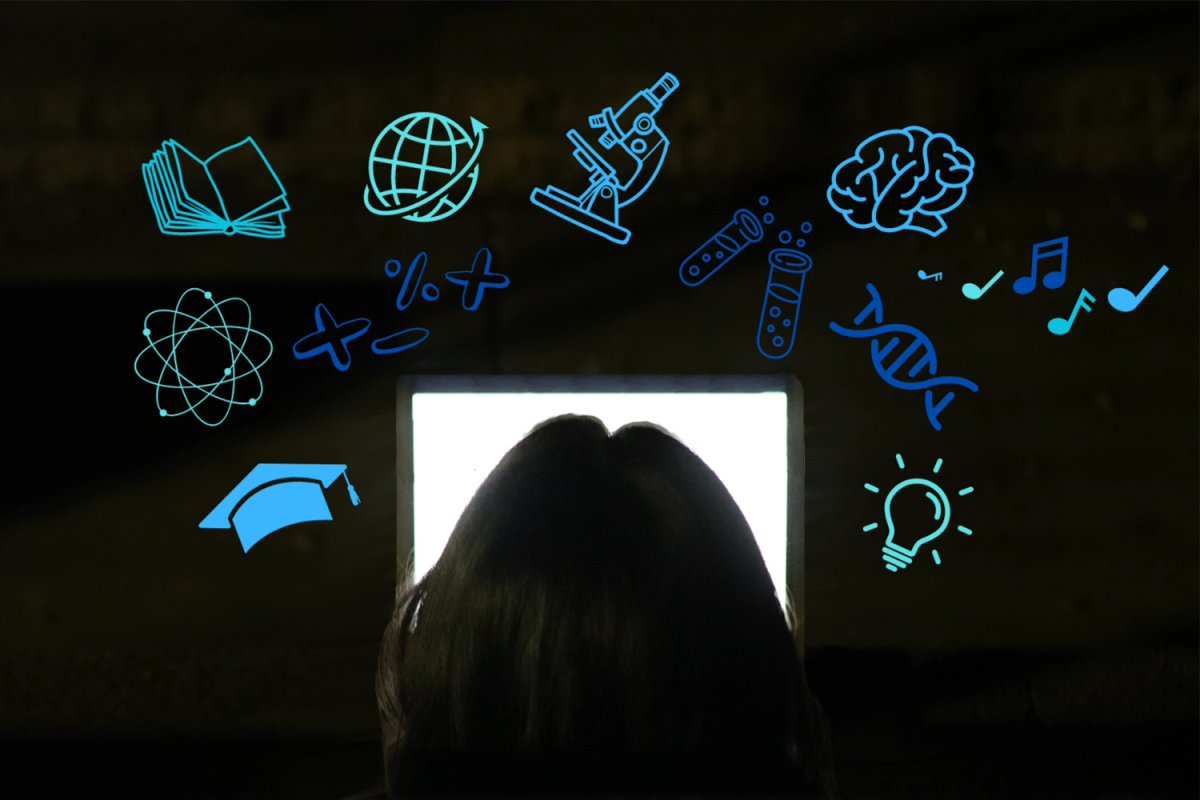Ninety-nine percent — a surge that reshaped education. In the confinement of 2020, traditional schooling found itself boxed in while EdTech emerged as the leading industry.
According to Exploding Topics, there has been a 99% increase in EdTech usage among K-12 schools since 2020, marking a significant turning point in the future of education.
Educational technology, commonly referred to as EdTech, is a rapidly growing teaching method that harnesses technology as its primary educational tool. Each company uses various EdTech approaches to achieve its distinct goals and mission.
As a senior at Carlmont, Sam Dechaine has experienced the transformative shift from traditional paperwork to a digital educational curriculum. This shift has profoundly impacted students, especially those like her, who have witnessed the transition firsthand.
“All assignments are online now, so I use screens pretty constantly,” Dechaine said.
Benefits
The popularity of EdTech brings numerous benefits for students within a learning environment.
Convenience is a prominent aspect, with the digital shift in coursework making it possible for students to prepare for most of their classes by simply bringing a device to school. Computers also provide instant access to thousands of resources at a student’s fingertips.
“It is definitely more convenient not to have a billion papers in my backpack, and I like the benefits that come with typing on a computer,” Dechaine said.
EdTech companies contribute to these benefits by making education more customizable and tailored to students’ needs and interests.
“There’s a growing movement in education, whether it’s because of, or just happens to be timed with the pandemic, which creates a comprehensive, interest-based, passion-led education,” said Ali Hancock, the Marketing Lead of Outschool.
With numerous classes to choose from, Outschool is an innovative educational platform that provides various engaging, small-group courses online. Distinguished by their uniqueness, local schools typically offer only a few of these classes. Subjects span a wide range, from Japanese to music theory.
“One of the biggest benefits, I’d say, is that Outschool offers variety for kids to be able to study anything they want,” Hancock said.
While students are vital to the education environment, teachers play an equally crucial role. EdTech companies extend their offerings beyond students, providing a diverse array of tools tailored for teachers as well. For instance, GoGuardian Teacher, a product offered by GoGuardian, enables teachers to engage with student screens, personalize learning resources, monitor student progress in real-time, and manage digital distractions, according to Emily Spadafore, the Senior Public Relations and Communications Manager at GoGuardian.
Anne Campagnet-Reed, a French teacher at Carlmont, frequently uses EdTech products to assist her curriculum and teaching methods. One of the programs she utilizes is Voces, which allows her to provide verbal feedback on assignments and assessments, fostering a personalized connection with each of her students.
“I’m able to point out things that I wouldn’t be able to do just in writing or wouldn’t have the time to do individually for each student if I didn’t have the program,” Campagnet-Reed said.
Challenges
The world of EdTech introduces both opportunities and challenges, notably impacting the learning experience for students and posing hurdles for teachers. The challenges are diverse, from distractions in the digital classroom to the consequences of increased screen time.
Teachers like Campagnet-Reed share their struggles in maintaining a focused learning atmosphere when students bring devices to school daily. The convenience of online work comes with the temptation for students to navigate unrelated websites, leading to scattered attention.
“It’s really hard to keep everybody together and focused on what’s going on in class when they’re thinking about other classes and other homework or catching up on assignments for this class,” Campagnet-Reed said.
The surge in technology usage is also accompanied by a rise in health concerns, primarily due to increased screen time. In a study conducted from December 2020 to April 2021 by the National Library of Medicine, children aged 4 to 12 years experienced a rise in screen time by 1.75 hours per day.
“I think a lot of students have problems with migraines now, and screentime is definitely up,” Dechaine said.
Excessive screen time has been associated with various health issues beyond migraines, including poor sleep, cardiovascular disease, poor stress regulation, and more, according to the National Library of Medicine.
In addition to health concerns, the impact on academic performance is evident. A Reboot Foundation study in June 2019 revealed that fourth-grade students who used technology in most classes scored fourteen points lower on the federally required reading exam than those who never used technology in the classroom.
Extending this perspective globally, the Programme for International Student Assessment (PISA), assessing students’ proficiency in math, science, and reading in over 90 countries, found that students reporting low to moderate use of school technology displayed better performance on the PISA than their counterparts with high technology use in a study conducted by Reboot in June 2019.
“I think students are trying harder to get the work done rather than necessarily understanding a concept being taught,” Campagnet-Reed said.
Financial impacts
Despite the achievements of EdTech, it comes with a price.
Private companies and governments are investing billions of dollars into EdTech. In 2021, a staggering $20.3 billion entered EdTech and education startups. Nevertheless, the post-pandemic era witnessed a stark decline in investments. In 2022, a reduced sum of $10.6 billion was invested in EdTech, and a mere $3.5 billion is projected for 2023, according to HolonIQ.
However, these investments have proven worthwhile, as EdTech emerged as a highly lucrative industry. In 2020, U.S. EdTech startups raised over $2.2 billion in venture and private equity capital across 130 deals, according to the EdSurge EdTech funding database. These substantial profits are only expected to grow, with predictions foreseeing EdTech expanding 2.5 times from 2019 to 2025, reaching a total global expenditure of $404 billion, according to HolonIQ.
The financial success is evident in numerous EdTech companies, including platforms like Outschool, which are experiencing significant growth driven by investments, acquisitions, and the launch of innovative services to transform the educational landscape.
“As of October 2021, Outschool’s valuation was $3 billion,” Hancock said.
A noteworthy example of this upward trend is GoGuardian, which made significant acquisitions – Pear Deck in 2020, Edulastic in 2021, and TutorMe in 2022. Furthermore, GoGuardian secured a $200 million strategic investment from Tiger Global Management, propelling its valuation to over $1 billion, as confirmed by Jeff Gordon, Director of Public Relations and Communications at GoGuardian.
With money pouring in and success emerging, the economic aspect further supports the potential of EdTech despite the significant investments made in the industry.
Future of EdTech
While EdTech has existed for over two decades, its recent growth has been particularly pronounced. The primary factor for this surge was the COVID-19 pandemic, which forced all education to shift online.
“Ever since COVID, everything has turned entirely online because I think teachers realized that was an easier route to go with their students,” Dechaine said.
As the EdTech industry continues to evolve, questions about the effectiveness of its platforms naturally arise. Companies, including Outschool, are actively seeking methods to measure the impact of their educational programs.
“Effectiveness and efficacy are important to us, but it’s also complicated because every class has different goals or objectives. We look at reviews, we look at feedback, and something we’re exploring as we head into 2024 and beyond is how can we put a metric against that,” Hancock said.
Amidst this digital shift, the introduction of Artificial Intelligence (AI) in the EdTech industry has opened new gateways of opportunity.
According to a survey by the International Data Corporation, 99.4% of educators believe AI will provide their company with a competitive edge in the coming years, with 15% considering it a game changer for EdTech.
“With the rise of AI technology and things like ChatGPT, I think some teachers are scared,” Dechaine said.
The rise to popularity is undeniably underway. One hundred million people are using ChatGPT on a weekly basis, according to OpenAI CEO Sam Altman. While the future of AI is still in its early stages, its potential is promising, and much anticipation is held for how it will impact the future of EdTech in the coming years.
Technology has made a lasting impact on education, and many believe that the use of technology in education will continue to grow, even as students return to traditional schooling.
“I think things are just going to get progressively more online,” Dechaine said. “And we might never go back to using paper and doing worksheets.”
























